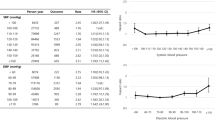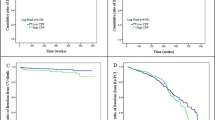Abstract
Strict blood pressure control is pivotal in the management of patients with aortic dissection (AD), but is frequently difficult to achieve. We determined antihypertensive medical therapy and levels of blood pressure (BP) control in 40 patients with chronic AD. Patient charts were reviewed for clinical variables, serial BP measurements, and antihypertensive drug therapy. Patients were divided into two groups: patients in group 1 had effective BP control (<135/80 mmHg), patients in group 2 had resistant hypertension (BP⩾135/80 mmHg despite prescription of at least three antihypertensive drugs). Overall, systolic BP (SBP) was 130±20 mmHg, and diastolic BP (DBP) was 72±13 mmHg. Patients received a median of 4 (1–6) antihypertensive drugs. β-blockers were used in 38/40 (95%) patients. Effective BP control was achieved in 24/40 (60%) patients (group 1), while 16/40 (40%) patients had resistant hypertension (group 2) despite receiving significantly more antihypertensive drugs (5 [4–6] vs 4 [1–5], P=0.001). Mean SBP was 116±9 (101–132) mmHg in group 1 and 151±13 (137–181) mmHg in group 2 (P<0.001); there was no difference in DBP. Group 2 patients had a significantly higher body mass index and were younger than patients in group 1. In conclusion, in the majority of patients with chronic AD, effective BP control can be achieved, but usually requires the combination of multiple antihypertensive drugs. However, in a significant proportion of patients (40%), who appear to be younger and more obese, medical therapy fails to achieve effective BP control despite use of a multiple drug regimen.
This is a preview of subscription content, access via your institution
Access options
Subscribe to this journal
Receive 12 digital issues and online access to articles
$119.00 per year
only $9.92 per issue
Buy this article
- Purchase on Springer Link
- Instant access to full article PDF
Prices may be subject to local taxes which are calculated during checkout


Similar content being viewed by others
References
Bernard Y et al. False lumen patency as a predictor of late outcome in aortic dissection. Am J Cardiol 2001; 87: 1378–1382.
Juvonen T et al. Risk factors for rupture of chronic type-B dissections. J Thorac Cardiovasc Surg 1999; 117: 776–784.
Wheat MW, Palmer RF, Bartley TD, Seelman RC . Treatment of dissecting aneurysms of the aorta without surgery. J Thorac Cardiovasc Surg 1965; 50: 364–373.
Erbel R et al. Diagnosis and management of aortic dissection. Eur Heart J 2001; 22: 1642–1681.
Januzzi JL et al. Refractory systemic hypertension following type B aortic dissection. Am J Cardiol 2001; 88: 686–688.
Grajek S et al. Results of long-term medical treatment of patients with arterial hypertension complicated by aortic dissection. J Hum Hypertens 1995; 9: 987–992.
Crawford ES et al. Surgical treatment of aneurysm and/or dissection of the ascending aorta, transverse aortic arch, and ascending aorta and transverse aortic arch. Factors influencing survival in 717 patients. J Thorac Cardiovasc Surg 1989; 98(Part 1): 659–673.
Chalmers J et al. 1999 World Health Organization-International Society of Hypertension Guidelines for the management of hypertension. Guidelines sub-committee of the World Health Organization. Clin Exp Hypertens 1999; 21: 1009–1060.
Amar J et al. Why is hypertension so frequently uncontrolled in secondary prevention? J Hypertens 2003; 21: 1199–1205.
Rackson ME, Lossef SV, Sos TA . Renal artery stenosis in patients with aortic dissection: increased prevalence. Radiology 1990; 177: 555–558.
Wagner A et al. Plasma endothelin in patients with acute aortic disease. Resuscitation 2002; 53: 71–76.
Nienaber CA, Eagle KA . Aortic dissection: new frontiers in diagnosis and management: part I: from etiology to diagnostic strategies. Circulation 2003; 108: 628–635.
Genoni M et al. Chronic beta-blocker therapy improves outcome and reduces treatment costs in chronic type b aortic dissection. Eur J Cardiothorac Surg 2001; 19: 606–610.
Gadowski GR, Pilcher DB, Ricci MA . Abdominal aortic aneurysm expansion rate: effect of size and beta-adrenergic blockade. J Vasc Surg 1994; 19: 727–731.
Brophy CM, Tilson JE, Tilson MD . Propranolol stimulates the crosslinking of matrix components in skin from the aneurysm prone Blotchy mouse. J Surg Res 1989; 46: 330–332.
Author information
Authors and Affiliations
Corresponding author
Additional information
Dr Eggebrecht is recipient of a research grant of the University Duisburg-Essen (IFORES 10+2).
Rights and permissions
About this article
Cite this article
Eggebrecht, H., Schmermund, A., von Birgelen, C. et al. Resistant hypertension in patients with chronic aortic dissection. J Hum Hypertens 19, 227–231 (2005). https://doi.org/10.1038/sj.jhh.1001800
Received:
Revised:
Published:
Issue Date:
DOI: https://doi.org/10.1038/sj.jhh.1001800
Keywords
This article is cited by
-
Interdisciplinary German clinical practice guidelines on the management of type B aortic dissection
Gefässchirurgie (2023)
-
Kardiologische Rehabilitation nach herzchirurgischen Eingriffen
Zeitschrift für Herz-,Thorax- und Gefäßchirurgie (2022)
-
Non-aortic cardiovascular disease in Marfan syndrome: a nationwide epidemiological study
Clinical Research in Cardiology (2021)
-
Acute aortic syndromes
Herz (2011)
-
Echokardiographische Abklärung des Patienten mit akutem Thoraxschmerz auf der Notfallstation
Intensivmedizin und Notfallmedizin (2006)



